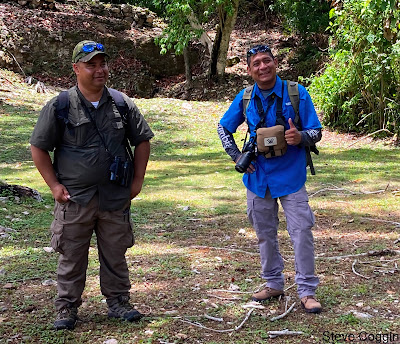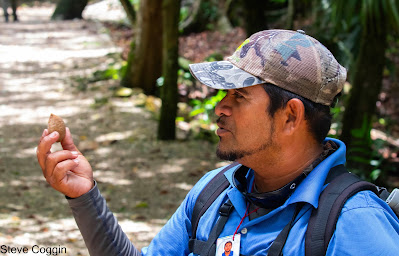 |
| The nut of a Cohune Palm (Attalea cohune). Lamanai Archeological Site, Belize. |
On a bird watching trip to Belize this summer I would sometimes lag behind the group and talk to one of our guides about the plants. They had many stories about plants and how the local people use them. Plants have been used for centuries by the Maya and others in Central America for food, construction, dyes and medicine.
 |
| Compound leaves of Black Poisonwood (Metopium brownei). Rio Bravo Conservation Area, Belize. |
 |
| Fruits of Black Poisonwood. Rio Bravo Conservation Area, Belize. |
Belizeans say if you see a Black Poisonwood (Metopium brownei),
you will find a Gumbo Limbo (Bursera simaruba) growing nearby. The Maya say these trees are manifestations
of good and bad, and they are always close together. The Maya name for Black Poisonwood is Chechen and this small tree is found on Caribbean
islands, Belize, northern Guatemala and southern Mexico. Black Poisonwood is a member of the Anacardiaceae,
the same family as Poison Ivy (Toxicodendron radicans). Black Poisonwood produces urushiol, the same toxin found in
Poison Ivy. Human contact with the bark
or leaves will raise a rash of itchy blisters that can last for over a
week.
 |
| The compound leaves of Gumbo Limbo (Bursera simaruba) look similar to those of Black Poisonwood. Rio Bravo Conservation Area. Belize. |
 |
| The peeling bark of Gumbo Limbo, the tourist tree. Rio Bravo Conservation Area, Belize. |
But growing near Black Poisonwood you will find Gumbo Limbo, Chakaj in Maya. It is a small tree with red bark that peels off in strips, giving rise to another common name, Tourist Tree. Local people say the bark looks like a tourist that spent too much time in the sun, red and peeling. Gumbo Limbo contains a natural remedy for Poisonwood rash. Irs bark is boiled in water and the liquid is applied to the sores. Gumbo Limbo contains a number of pharmacologically active compounds and has many uses in traditional medicine.
 |
| The giant leaves of a Cohune Palm. Lamanai Archeological Site, Belize. |
Cohune Palms (Attalea cohune), Mop in Maya, are giants. The trees may reach 80 feet in height and single fronds can be more than 60 feet long. Cohune Palms produce nuts that are were harvested by the Maya to extract palm oil and the nuts are favorite foods of small rainforest mammals. The huge fronds are used in making the thatch roofs of buildings. At the Lamanai Archeological Site is a palapa, a building with open sides and a Cohune Palm roof. The palapa’s roof was made of 15,000 overlapping Cohune Palm fronds. Tradition has it that the best time to cut the fronds is during the full moon. The Lamanai palapa’s roof was made in 1999 so I am sure these fronds were cut during the proper moon phase.
 |
| Palapa with thatch roof made of Cohune Palm fronds. Lamanai Archeological Site, Belize. Photo by Diane Coggin. |
 |
| Interior view of palapa thatch roof. Lamanai Archeological Site, Belize. Photo by Diane Coggin. |
Logwood (Haematoxylum campechianum), Ek in Maya, is a small tree with a significant history. This humble tree played a major role in the Golden Age of Piracy, the textile industry in late Renaissance Europe and medical histology. This member of the Fabaceae has compound leaves with heart-shaped leaflets. Logwood grows along watercourses and other wet areas in Southern Mexico, Central America and Caribbean Islands.
 |
| Compound leaves of Logwood (Haematoxylum campechianum). Crooked Tree Wildlife Sanctuary, Belize. |
The wood of Logwood is deep reddish orange and the genus name, Haematoxylum,
is derived from Greek meaning blood wood.
A dye, hematoxylin, is extracted from the wood and when combined with
other chemicals is used to color fabrics red, blue, purple and even black. In 16th century Europe, brightly colored
clothing was reserved for the elite and logwood for dyes was in high demand. The long-running wars
between England and Spain provided opportunities for English pirates to seize
Spanish ships carrying all manner of American treasures including Logwood. Some English pirates decided to
eliminate the middleman and became Logwood cutters along the coast of what is
now Belize. These pirates/Logwood
cutters are the reason English and not Spanish is the official language of Belize.
 |
| Wood of Logwood. Crooked Tree Wildlife Sanctuary, Belize. |
Early microscopists including Robert Hooke, one of founders of the discipline, used hematoxylin to stain specimens. As microscopes improved, practitioners noted hematoxylin preferentially stained cell nuclei. Hematoxylin is still used to stain tissues for microscopic examination. One application is the Pap smear. This test was developed by Dr. George Papanicolaou in the 1920s and uses several stains including hematoxylin to detect precancerous and cancer cells of the cervix. In a Pap smear, abnormal cells have larger, more darkly stained nuclei and are easily seen. Countless lives have been saved by Pap smears that have Logwood as a central component.
 |
| Cowfoot (Bauhinia divaricata). Rio Bravo Conservation Area, Belize. |
Cowfoot (Bauhinia divaricata), Zax-suluv-tok in Maya, is a small tree found from Mexico to Costa Rica and on some Caribbean islands. It is yet another member of the pea family (Fabaceae). The common name of Cowfoot comes from the resemblance of its heart-shaped leaves to the hoof print of a cow. The genus Bauhinia is well known for producing medicinal compounds. These plants have been traditionally used to treat a wide range of conditions from diabetes to diarrhea to kidney disease. Our guide told us Cowfoot is used by women for birth control. According to local sources, Cowfoot tea can be used for 8 months to prevent pregnancy but longer use will cause sterility.
 |
| The spiny fruits of Achiote (Bixa orellana). Rio Bravo Conservation Area, Belize. |
 |
| Red seeds of Achiote in the fruit. Rio Bravo Conservation Area, Belize. |
Achiote (Bixa orellana) or k'uxub in Maya, is a small tree native to the American tropics. Bixa orellana is the source of a dye, a spice and a pigment for body paint. The brown, spiny fruits of Achiote contain many small red seeds. These are ground into a powder called annatto that is added to a variety of foods to add flavor and color. Annatto is still in use as a natural coloring agent for cheese, ice cream, soup and other foods. One day for lunch at the La Milpa Lodge we were served a soup made with annatto. This delicious dish contained chicken, egg, onion, pepper and spices including the ground seeds of Achiote as ingredients.
In the global north we are largely insulated from what the plants around us have to offer. We have systems of agriculture, medicine and technology that allow us to live in ignorance of plants. But people in other cultures retain an intimate relationship with their plants. I am always impressed with this deep knowledge and with what we have lost.
 |
| Belizean guides Roni Martinez and Abimael Moralez. |
 |
| Guide Amir Reyes. |
No comments:
Post a Comment